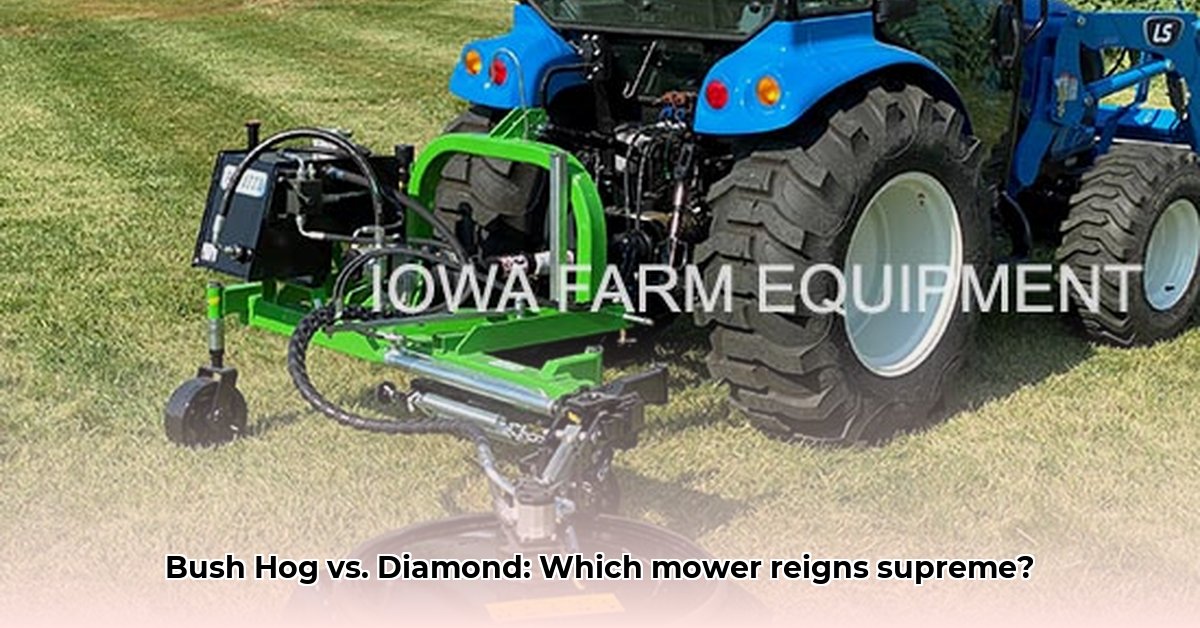
Choosing the right side mower significantly impacts farm efficiency and profitability. This comparative review analyzes Bush Hog and Diamond boom mowers, guiding you through the selection process based on your specific needs and budget. We'll examine reach, cutting capacity, hydraulic systems, maintenance, and safety features to help you make an informed decision. For more options, check out these small tractor mowers.
Reach and Cutting Capacity: Matching the Mower to Your Needs
Both Bush Hog and Diamond offer powerful options, but their strengths lie in different areas. Bush Hog's RMB series boasts impressive reach, extending from 11.5 to 18 feet. This adaptability is ideal for navigating obstacles in large fields. Cutting capacity varies depending on the attachment: flail heads for lighter vegetation (1-2 inches), cutter bars for medium growth (up to 1 1/4 inches), and rotary heads for heavy-duty cutting (up to 4 inches).
Diamond Mowers prioritize heavy-duty cutting with their rotary systems. While reach is limited by the cutting width (60 or 72 inches), their twin-rotary design ensures rapid coverage, making them perfect for large-scale projects like roadside clearing. These mowers also offer a robust 4-inch cutting capacity, easily handling thick brush and weeds. Which reach and cutting capacity best suits your acreage and vegetation?
Hydraulic Systems: Power and Protection
Bush Hog generally utilizes simpler, self-contained hydraulic systems. Diamond, however, incorporates more advanced features, including an automatic cooling fan and obstacle protection. These enhancements contribute to reduced downtime and increased operator safety. While both systems are reliable, Diamond's advanced features might justify the added cost for frequent, large-scale mowing operations. What level of protection and automation is most important to your operation?
Tractor Power Requirements: Avoiding Overburdening or Underpowering
Matching your tractor's horsepower to the mower's requirements is paramount. Bush Hog RMB models typically necessitate higher horsepower tractors compared to Diamond's PT5 models. Crucially, consult your tractor's specifications and compare them to the mower's requirements before purchase. Using a mower exceeding your tractor's capabilities is dangerous and inefficient, while using too weak a tractor will result in breakdowns and reduced productivity. How much horsepower does your tractor have and what are the specific requirements of each model you are considering?
Maintenance and Long-Term Costs: Minimizing Downtime and Maximizing Lifespan
Diamond Mowers often receive praise for their streamlined blade maintenance, employing replaceable inserts for quick and cost-effective repairs. This minimizes downtime and lowers long-term expenses. While Bush Hog mowers offer features like hydraulic or mechanical breakaways and various accessories, detailed maintenance information can be less readily available. Therefore, thoroughly research maintenance requirements for specific models and factor these ongoing costs into your overall budget.
Safety Features: Protecting Operators and Equipment
Safety is paramount. Bush Hog RMB models are designed for tractors with cabs and require protective screens, especially when operating rotary heads. Diamond emphasizes the safety aspects of its hydraulic system, including obstacle protection for both the machine and the operator. Added features like auxiliary lighting improve visibility during low-light operations. Prioritize appropriate safety features based on your operating environment and frequency of use. What safety features are non-negotiable for your farm operation?
Comparative Feature Table: Bush Hog vs. Diamond
| Feature | Bush Hog RMB Series | Diamond Mowers |
|---|---|---|
| Reach | 11.5 - 18 ft | Limited by cutting width (60" or 72") |
| Cutting Capacity | 1-2", 1 1/4", 4" (depending on attachment) | 4" |
| Hydraulic System | Self-contained | Advanced system with automatic cooling & obstacle protection |
| Maintenance | Varies by model; consult owner's manual | Easier blade maintenance with replaceable inserts |
| Power Requirements | Higher horsepower tractors required | Lower horsepower requirements |
| Ideal Application | Versatile, good for various terrains and budgets | Large-scale vegetation management, roadside clearing |
Choosing the Right Mower: A Step-by-Step Guide
- Assess your needs: Define the type and density of vegetation, the size of your property, and the terrain.
- Check tractor compatibility: Verify your tractor's horsepower and weight capacity against the mower's specifications.
- Compare features and costs: Analyze the comparative table above, focusing on reach, cutting capacity, hydraulic systems, and long-term maintenance.
- Research specific models: Review manufacturer specifications and user reviews for detailed information.
- Obtain demonstrations: Arrange demonstrations with local dealers to test mowers under realistic conditions before making a final decision.
By following these steps and carefully considering the factors outlined in this review, you can select the boom mower that best meets your operation's needs and optimizes your efficiency and profitability. Remember, investing time in research and thorough comparison will prevent costly mistakes in the long run.